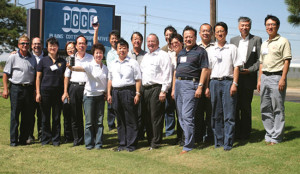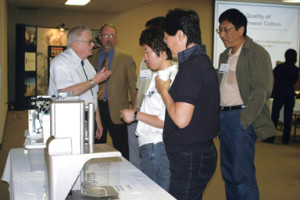PCCA Hosts One-Day Seminar for Group
By Allison Sansom

Wally Darneille (center) with the visiting China Cotton Association delegation and representatives from the National Cotton Council and Cotton Council International.
Plains Cotton Cooperative Association (PCCA) and its President and CEO, Wally Darneille, hosted a group of leaders from the China Cotton Association (CCA) for a one-day seminar during their visit to the U.S. Cotton Belt in September. Their focus was on learning about the U.S. cotton industry.
The tour, sponsored by the National Cotton Council (NCC) and Cotton Council International (CCI), also included stops in Washington, DC, major cotton growing areas, and at cotton research and trading centers in Cary, N.C., Memphis, Tenn., and Fresno, Calif.
According to Cotton Council International, the delegation’s schedule in Washington consisted of briefings by the NCC, CCI, the White House, the Senate Agriculture Committee, and USDA. They also toured farms and gins in Arkansas and California, a USDA classing office, and Cotton Incorporated’s world headquarters. The delegation participated in special regional seminars featuring the U.S. cotton industry in the Southeast, Mid-South, Southwest and West.
CCA’s visit to PCCA included a description of China’s cotton industry by Madame Gao Fang, Secretary General of the CCA. Rickey Bearden, a cotton producer from Yoakum County, spoke on the economic impact of cotton in the West Texas region. The quality characteristics of U.S. cotton in the region, the marketing of regional cotton styles, and the important role of interest organizations also were discussed at the meeting.
Darneille said China imports more cotton from Texas each year. The cotton quality in West Texas has evolved over the years to become more desirable for China, and PCCA has emphasized this in its marketing efforts. The meeting also was an opportunity for PCCA personnel to meet face-to-face with customers “on our home turf.”
“We purposely designed our meetings and lunch with them to demonstrate our understanding and appreciation of their culture,” Darneille said. “Seemingly simple things like serving lunch Chinese style with a “lazy susan” on the table, and serving them Chinese tea made a huge impression on the group,” he added. “They also left with a better understanding of West Texas cotton and will help spread the message of how PCCA can serve their textile mills.”

Retired PCCA employee Emerson Tucker explains the evolution of HVI cotton fiber testing equipment.
A Cotton Council International spokesperson said information from the CCA delegation during the leadership exchange has helped the U.S. cotton industry to understand China, the world’s largest producer, importer and consumer of cotton. China bought $2.45 billion worth of U.S. cotton during the 2005-2006 marketing year, but the U.S. market share has dropped during the past two years due to strong competition from India, Brazil and other suppliers. Understanding Chinese cotton needs and business practices should help facilitate U.S. cotton sales.
The Chinese delegates mentioned U.S. cotton’s advantages in the market are its consistent quality, lack of contamination, standardized USDA classing, and timely shipment. On the other hand, one issue that was stressed by the delegation was the fact that reducing the occurrence of neps and short fiber content in U.S. cotton would help improve trade.
CCA executives pointed out that China’s 2006-2007 production was higher than reported, and prospects for the 2007-2008 crop are good. The CCA, other industry associations, and some Chinese government agencies believe textile output there will grow moderately in 2007-2008. The statement was based on a slower growth rate influenced by changes in government policies, the cost and availability of labor, and increasing costs of production. They believe Chinese cotton imports for 2007-2008 will remain mostly even with the previous marketing year. In the future, delegation members foresee that production will level off at slightly higher numbers, and imports will continue to increase due to the growth in domestic markets and export demand for textile and apparel products. The speed of this growth will be determined greatly by local and global consumer demand and the price competitiveness of Chinese goods.
Trade policy discussions focused on the future of China’s tariff rate quota system, both fixed and variable, and its impact on Chinese production, cotton imports and the competitiveness of Chinese exports. CCA officials stated that internal Chinese discussions could yield a two-tiered, fixed rate system that ultimately could increase the price competitiveness of imported cotton fiber and exported products while still providing steady income at the farm gate in China.
CCA is a non-profit organization established voluntarily by China’s cotton farmers, cotton farmer cooperatives, cotton textile enterprises, cotton research institutes, enterprises engaged in cotton production, purchasing, processing and operation, and other institutions. The CCA is supervised by the Ministry of Civil Affairs and reports directly to the All-China Federation of Supply and Marketing Cooperatives.
The CCA was modeled after the National Cotton Council to include all segments of the Chinese cotton industry. A Memorandum of Understanding was signed in 2006 between the NCC and the CCA that promised cooperation between both countries’ cotton industries. U.S. industry representatives are committed to working with the CCA so that leaders in both countries can better understand each other’s cotton industries and enhance future business relations.
“While PCCA personnel visit Chinese buyers on a regular basis, it is time- consuming and expensive,” Darneille noted. “Thus, it was gratifying to have them ‘come to us’ for a change. We also are certain that this visit gave them a better appreciation of how PCCA adds value in the supply chain, and this will increase our selling opportunities in the future.”


